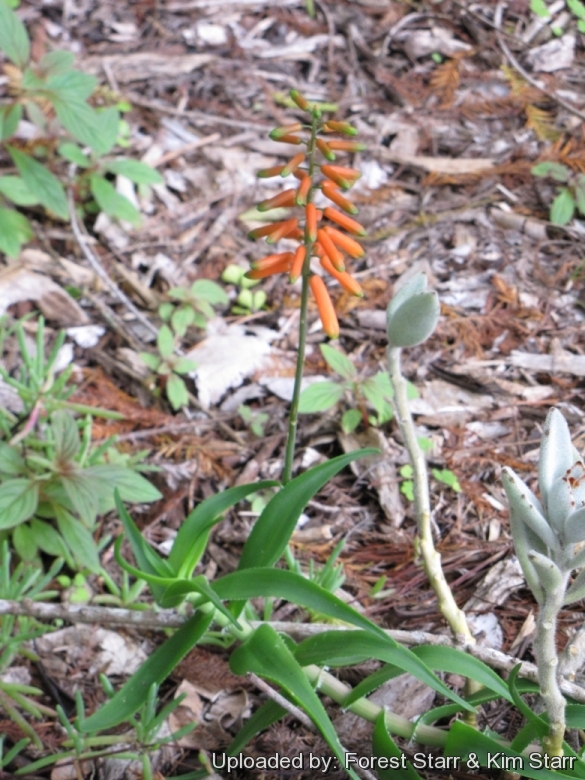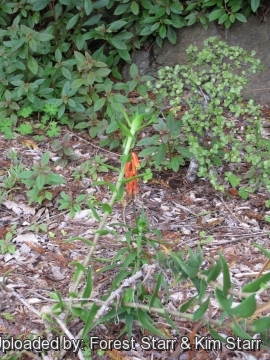Accepted Scientific Name: Aloiampelos ciliaris (Haw.) Klopper & Gideon F.Sm.
Phytotaxa 76(1): 10 [7 Jan 2013] [epublished]

Aloe ciliaris (Aloiampelos ciliaris) Photo by: Forest Starr & Kim Starr
Flowering habit at Kula Botanical Garden, Maui, Hawaii (USA). March 07, 2011.
Origin and Habitat: RSA (Eastern Cape; extends from Uitenhage to the Suurberg in a wide coastal and inland belt to the Kei River and Kentami). Aloe ciliarisSN|29185]]SN|29185]] var. ciliaris has the widest distribution in the area. There is no evidence supporting reports such as Reynolds (1950) that A. ciliaris occurs wild in Kenya.
Habita and ecology: Aloe ciliarisSN|29185]]SN|29185]] is naturally widespread in the coastal and thicket vegetation of the Eastern Cape. Especially in dry river valleys where they grow in thorny forests, often semi-epiphytic, their long stems pushing rapidly upwards and out through the thicket canopy. Their recurved leaves act as hooks, allowing the plant to anchor itself in the thick vegetation.
Synonyms:
See all synonyms of Aloiampelos ciliaris
back
Accepted name in llifle Database:Aloiampelos ciliaris (Haw.) Klopper & Gideon F.Sm.Phytotaxa 76(1): 10 [7 Jan 2013] [epublished]Synonymy: 6
Accepted name in llifle Database:Aloiampelos ciliaris var. redacta (S.Carter) Klopper & Gideon F.Sm.Phytotaxa 76: 10. 2013 [7 Jan 2013] [epublished]Synonymy: 2
Accepted name in llifle Database:Aloiampelos ciliaris var. tidmarshii (Schönland) Klopper & Gideon F.Sm.Phytotaxa 76: 10. 2013 [7 Jan 2013] [epublished]Synonymy: 4
back
Common Names include:
ENGLISH: Common climbing aloe, Climbing aloe, Fringe-leaved Aloe
AFRIKAANS (Afrikaans): Klimaalwyn
ARABIC ( لعربية ): ألوي سليارس
UKRAINIAN (Українська): Алое війчасте, алое ціліаріс
Description: Aloe ciliaris (the Common Climbing Aloe) is a thin, caulescent, branching, and rapidly growing climbing or scrambling Aloe with fleshy leaves that are strongly recurved (helping to anchor the tall stems in dense thickets and assist the aloe in climbing). If there are no nearby trees to act as host and support, it just forms a straggly shrub. Once it reaches the sun its handsome red flowers appear near the end of the long weak stems which climb and straggle through the undergrowth. It was introduced into cultivation in England by Bowie as early as 1820. Three varieties are recognized, the nominate form, var. redacta (S.Carter) Klopper & Gideon F.Sm. and var. tidmarshii (Schönland) Klopper & Gideon F.Sm.
var. ciliaris: The variety ciliaris (hexaploid) distingushes from other varieties for the largest flowers (perianth 28-35 mm long), and is easily recognised by the ciliate leaf base encircling the stem, projecting outwards like a fringed collar (cilia 2-4 mm long).
Derivation of specific name: Aloe ciliaris derives its name from the tiny white "eyelashes" (=cilia) that circle the stem, at the base of the leaf.
Stems:It has swollen basal caudex from which emerge many long semi-woody, untidy, shrubby or sarmentose brances, up to 5 or more metres long when fully developed with leaves and flowers near the terminal ends; branches terete, 6-15 mm in diameter, with internodes 12-18 mm long, grey barked with age but toward the growth tips are more pliant with dried leaf bases and striated green markings near the tips.
Leaves: Laxly disposed over 30-60 cm or more only near apex. Blade linear,-lanceolate, long acuminate, distinctly auriculate, amplexicaul, spreading, 7-15(-8) cm long, 12-25 mm broad, acuminate, green, flat on the face in the lower half, thin to slightly fleshy (ca. 2-15 mm thick in the middle), green, more or less glaucous, neither spotted nor striped or obscurely green-lineate, teeth of the margin minute, soft white, ca. 1 mm long, deltoid, white, growing gradually larger and distinctly ciliate towards the base of the leaf shorter towards leaf-tip, firm, white, 3 mm apart. The marginal teeth extend around the back of their clasping base with fringe of 2-4 mm cilia. The recurved leaves act as hooks, to anchor the plant as it climbs.
Inflorescence (raceme): Rising vertically, lateral from near the tips 20-30 cm long, usually simple, sometimes with 1 Branch. Raceme cylindric, oblong, lax to dense 8-15 cm long, 4 - 5 cm in diameter with 24 - 30 flowers. Peduncle slender, simple, 7-22 cm long. Pedicels 4-8 mm long. Bracts minute, ovate-acuminate, lanceolate or narrowly deltoid-acuminate, 3-5 mm long, 1-2 mm wide, 1-3-nerved.
Flowers: Flowers dangling downwards, scarlet, yellowish-green at mouth, cylindric, (25-)28-35(-40) mm long. Perianth cylindrical, slightly clavate, base very shortly attenuate, gradually enlarging above, bright red, tube cylindrical; outer segments oblong, free for 5-7 mm, inner segments free segments; stamens not exserted, anthers exserted 2-4 mm. Ovary ca. 4-5 x 2 mm, pale green, style finally exserted 2-4 mm.
Blooming season: Flowers can appear throughout the year but primarily in spring.
Fruit: 18 mm long, 9 mm in diameter.
Remarks: Aloe ciliaris can be differentiated from other climbing aloes by the way that the soft, white, hair-like teeth (=cilia) that grow along the margins of the leaves, extend all the way around the stem, at the base of the leaf.
Chomosome number: 2n = 42
Related species: Some other species in this group are: Aloe tenuior, Aloe gracilis, Aloe commixta, Aloe juddii and Aloe striatula.
Subspecies, varieties, forms and cultivars of plants belonging to the Aloiampelos ciliaris group
The Aloiampelos ciliaris (Aloe ciliaris) complex comprises plants with 3(-4) levels of ploidy, distinguished in varieties and forms.
- Aloe ciliaris f. gigas Resende: Pentaploid (2n = 35) has leaves larger than in the other varieties ca. 15-30 cm long, 4 cm broad and 4-5 mm thick.
 Aloiampelos ciliaris (Haw.) Klopper & Gideon F.Sm.: Esaploid (2n = 42) has the largest flowers (perianth 28-35 mm long), and the widest distribution in the area. Leaves 7-15(-8) cm, 12-25 mm broad, with ciliate leaf base encircling the stem, projecting outwards like a fringed collar. Distribution: Eastern Cape.
Aloiampelos ciliaris (Haw.) Klopper & Gideon F.Sm.: Esaploid (2n = 42) has the largest flowers (perianth 28-35 mm long), and the widest distribution in the area. Leaves 7-15(-8) cm, 12-25 mm broad, with ciliate leaf base encircling the stem, projecting outwards like a fringed collar. Distribution: Eastern Cape.- Aloiampelos ciliaris var. redacta (S.Carter) Klopper & Gideon F.Sm.: Tetraploid (2n = 28) sand dunes. Leaf sheath cilia 1-2 mm. Bracts 4-5 mm. Peduncle 12-14 mm. Flowers smaller (21-25 mm long). Intermediate between the other 2 varieties, but not of hybrid origin. Distribution: Eastern Cape.
- Aloiampelos ciliaris var. tidmarshii (Schönland) Klopper & Gideon F.Sm.: Diploid (2n = 14) Leaves 7-10 x 1.5-2 cm, sheath cilia minute, less than 1 mm long; Inflorescence racemes sublax; Flowers small 16-25 mm long. Distribution: Eastern Cape.
Notes: This climbing aloe seems to have developed from the smaller, rarer, more delicate diploid Aloiampelos ciliarisSN|29184]]SN|29184]] var. tidmarshii (syn: Aloe tidmarshi) and to have spread out across the region relatively recently.
Bibliography: Major references and further lectures
1) Forest & Kim Starr “Aloe ciliaris (Climbing aloe)”. Plants of Hawaii. <http://www.starrenvironmental.com>. Web. 26 Oct. 2014.
2) Brandham, P.E. and Carter, S. 1990. "A revision of the Aloe tidmarshii/A. ciliaris complex" in South Africa. Kew Bulletin 45(4):637-645.
3) J. G. BAKER “Flora Capensis” page 253 1897
4) J.P. Roux “Flora of South Africa” 2003
5) Urs Eggli “Illustrated Handbook of Succulent Plants: Monocotyledons: Monocotyledons” Springer Science & Business Media, 17/Jul/2001
6) Wikipedia contributors. "Aloe ciliaris." Wikipedia, The Free Encyclopedia. Wikipedia, The Free Encyclopedia, 26 Feb. 2013. Web. 26 Oct. 2014.
7) Bailey, L. H. & E. Z. Bailey. “Hortus Third” i–xiv, 1–1290. MacMillan, New York.1976.
8) Susan Carter, John J. Lavranos, Leonard E. Newton, Colin C. Walker: “Aloes. The definitive guide.” Kew Publishing, Royal Botanic Gardens, Kew 2011
9) Urs Eggli “Illustrated Handbook of Succulent Plants: Monocotyledons: Monocotyledons” Springer Science & Business Media, 17/Jul/2001
10) Gideon F. Smith, Colin C. Walker, Estrela Figueiredo: "What’s in a name: epithets in Aloe L. (Asphodelaceae) and what to call the next new species." In: Bradleya. 28: 89. 2010
11) SANBI. 2014. "Aloe ciliaris Haw. var. ciliaris." National Assessment: Red List of South African Plants version 2014.1. Accessed on 2014/10/26
12) Doreen Court “Succulent Flora of Southern Africa” CRC Press, 01/Jun/2000
13) Mary Irish “Gardening in the Desert: A Guide to Plant Selection & Care” University of Arizona Press, 2000
14) Sabina George “Ornamental Plants” New India Publishing, 09/Jul/2009
15) San Marcos Growers contributors “Plant Database Search Results > Aloe ciliaris San Marcos Growers <http://www.smgrowers.com>. Web. 26 Oct. 2014.
 Flowering habit at Kula Botanical Garden, Maui, Hawaii (USA). March 07, 2011. (Aloiampelos ciliaris) Photo by: Forest Starr & Kim Starr
Flowering habit at Kula Botanical Garden, Maui, Hawaii (USA). March 07, 2011. (Aloiampelos ciliaris) Photo by: Forest Starr & Kim StarrSend a photo of this plant.The gallery now contains thousands of pictures, however it is possible to do even more. We are, of course, seeking photos of species not yet shown in the gallery but not only that, we are also looking for better pictures than those already present.
Read More... Cultivation and Propagation: Aloe ciliaris, is a worthwhile aloe for the garden is actually a true climbing semi-epiphytic vine. It is an easy and rewarding plant that usually does not give many problems in cultivation. Because the plant does not have tendrils or other clinging structures, it must be given a trellis, tree, or shrub in which to climb. It is grown mainly as an ornamental or as an accent plant, but is also an excellent and impenetrable hedge plant. It grows much better outdoors in spring and summer, it is also perfect for the bright windowsill. This is a great aloe used as a rambling groundcover or as a vine with some support - very nice running up a large palm. Its handsome red flowers appear near the end of the long weak stems which climb and straggle through the undergrowth.
Growth rate: This is the fastest growing of all Aloes, and it will tolerate drought and neglect once established.
Soil: Grow it in light, fertile, well-drained, moderate soils, with a slightly acidic pH (5-6).
Exposure: It is a shade lower that needs filtered sun to half shade, but grows well in full sun too, but will redden with more light exposure.
Watering:* Regular water in summer, keep dryer in winter, needs good drainage. It is drought tolerant but more lush and green with irrigation but plants in un-irrigated sites take on a nice chocolate brown colour.
Maintenance: Removal of old flower stalks; It is a suckering species, and one plant can eventually cover a large area. Divide the crowded clumps periodically. During the winter months, the plants should be grown cool to initiate flower development (about 5-10°C).
Hardiness: It can tolerate moderate frost but is sensitive to severe frost.
Traditional uses: Aloe ciliaris, is good for washing in, also to protect you from your enemies. It leaves you "slippery", hard to find.
Propagation: Seed, suckers, division of older plants. This species is easily propagated from a branch or stem cut off, allowed to dry for a day or so until the wound has sealed, and then planted in well-drained soil or sand. They need not be rooted in any particular place and then transplanted, but can be placed directly into their permanent place in the garden. This aloe can also be grown from seed, sown in spring. Seed should take three to four weeks to germinate, and the seedlings must be protected from frost.











